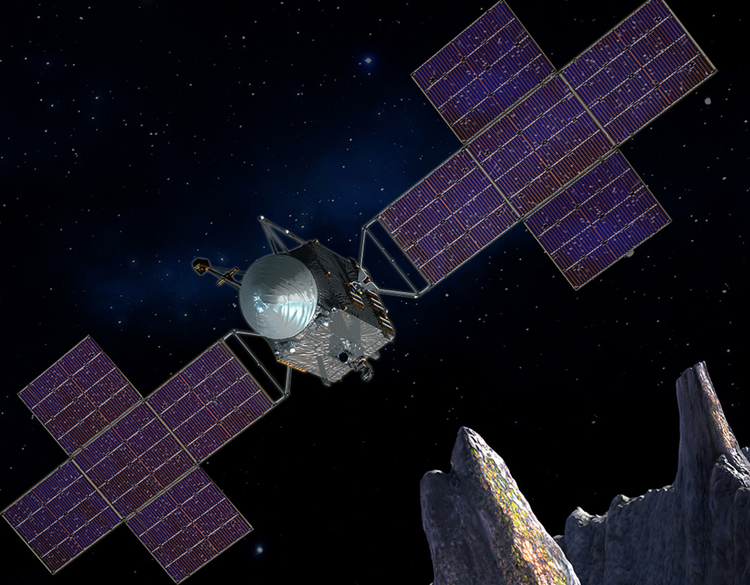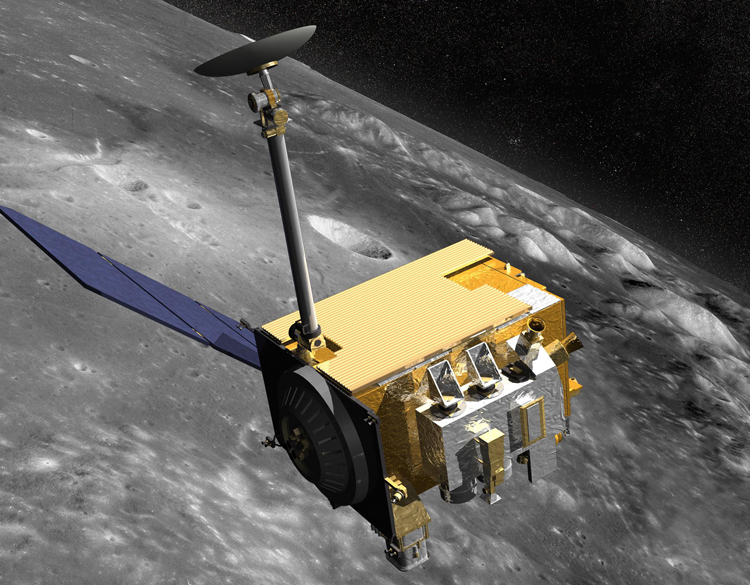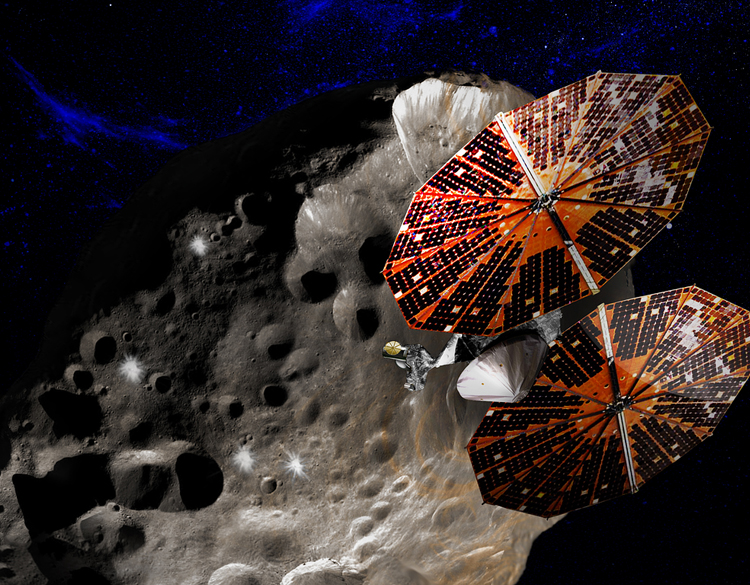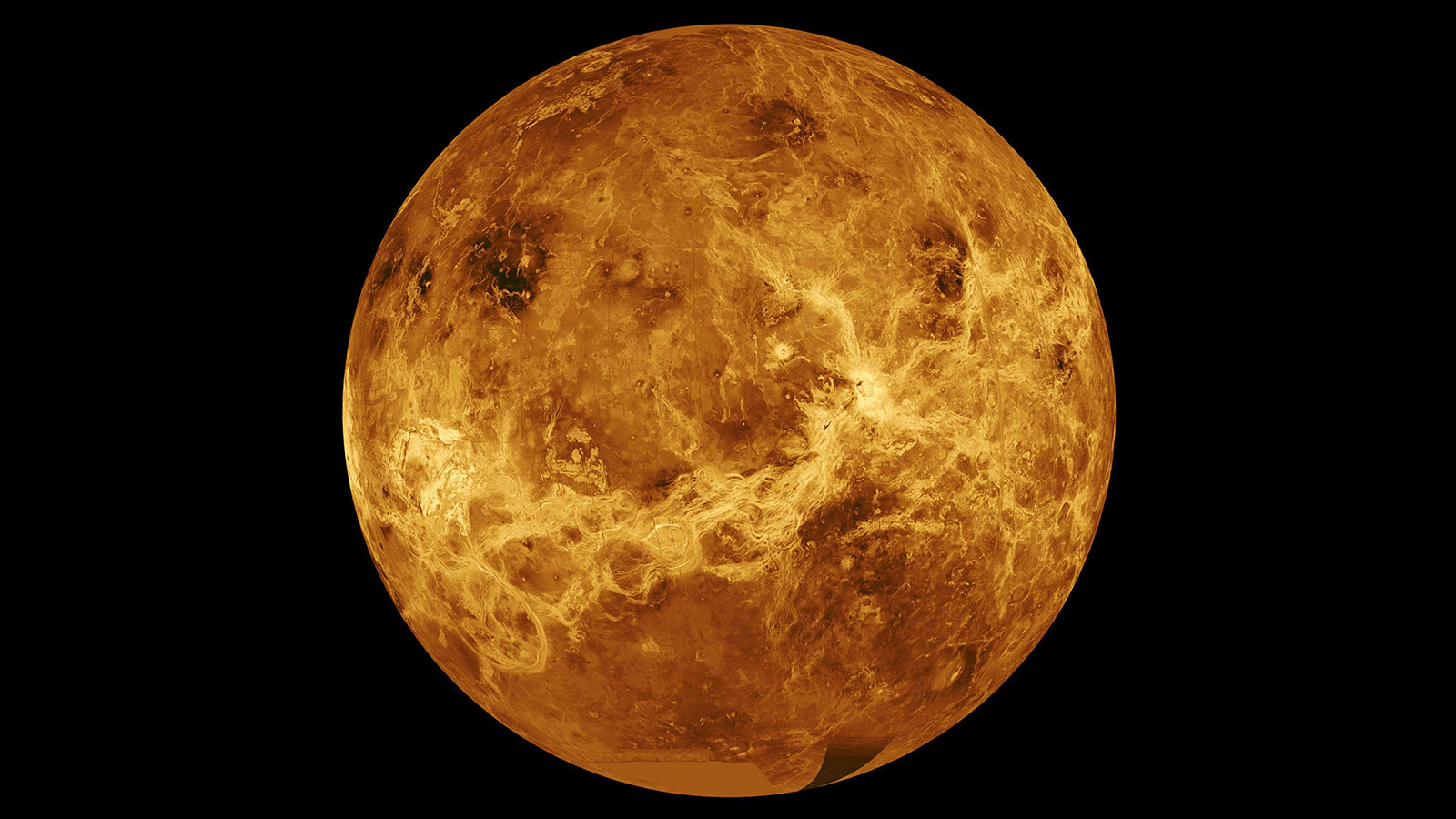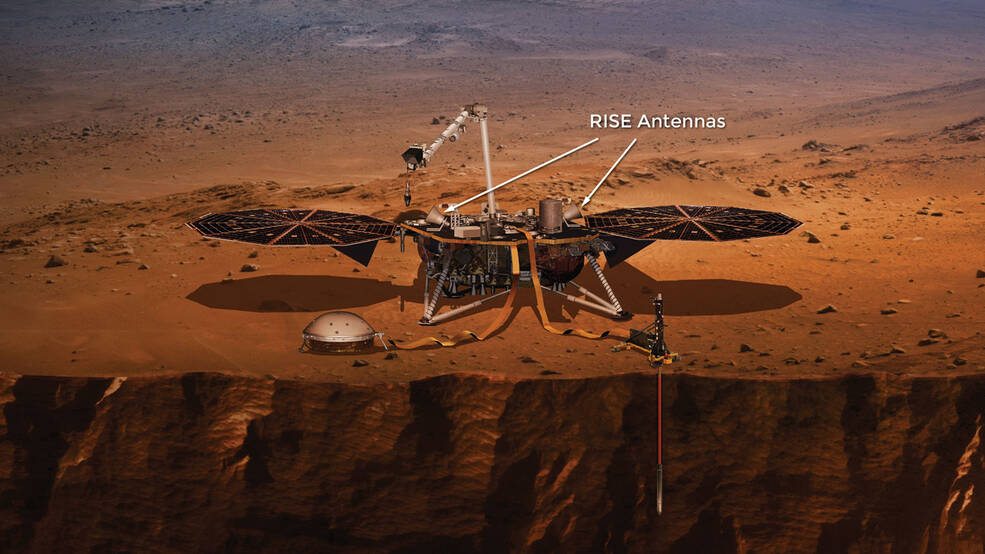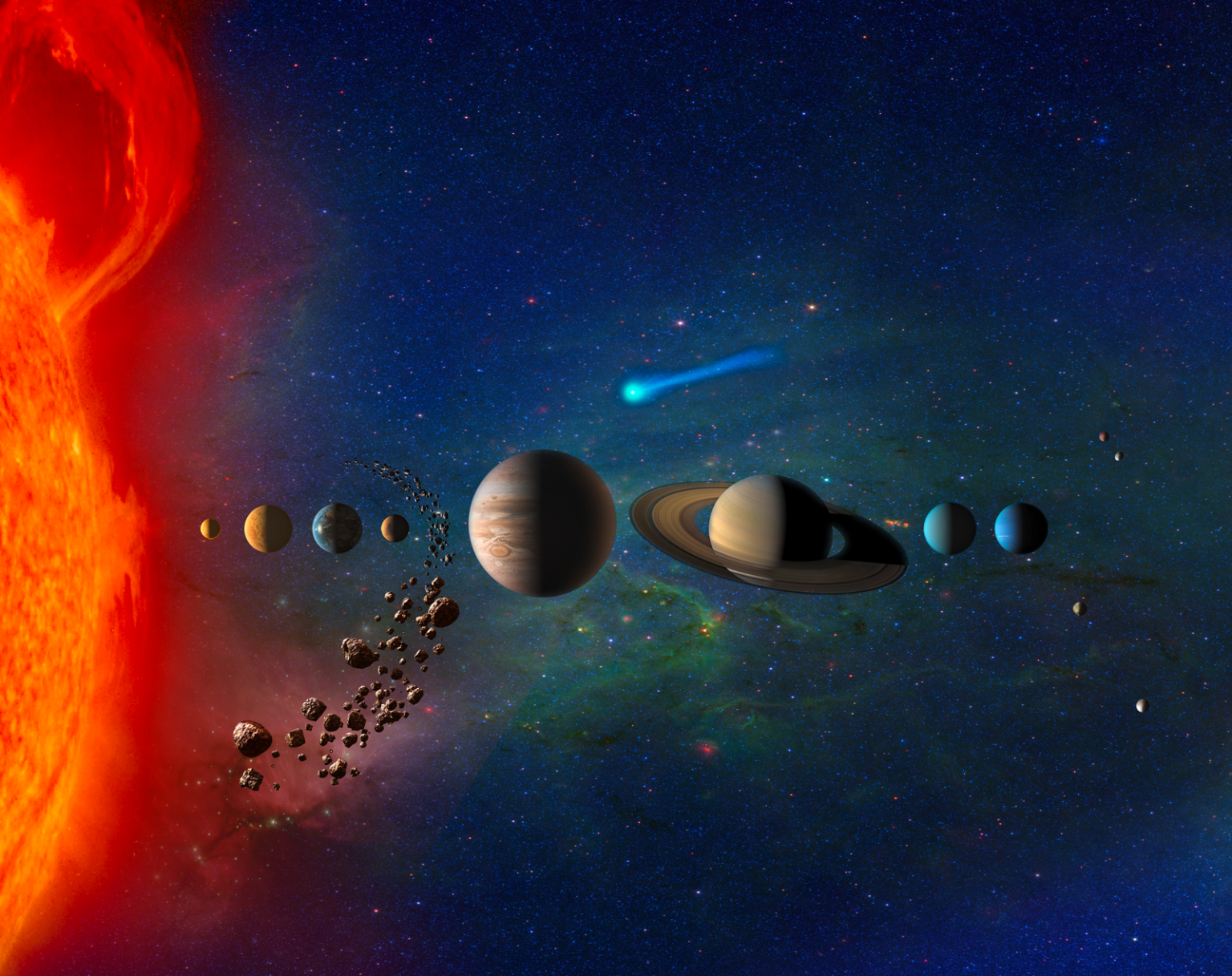
Discovery Program
Discovery Program
NASA’s Discovery Program gives scientists a chance to dig deep into their imaginations and find new ways to unlock the mysteries of our solar system. When it began in 1992, the program represented a breakthrough in the way NASA explores space. Discovery invites scientists and engineers to assemble a team to design exciting, focused planetary science missions that deepen what we know about the solar system and our place in it.
As a complement to NASA’s larger “flagship” planetary science explorations, our goal is to achieve outstanding results by launching more smaller missions using fewer resources and shorter development times. Our purpose is to deepen human understanding of the solar system by exploring the planets, their moons, and small bodies such as comets and asteroids. Discovery missions have achieved ground-breaking science, each taking a unique approach to space exploration, doing what’s never been done before, and driving new technology innovations that may also improve life on Earth.
The following missions have been selected under the Discovery Program.
Active | Future | Past
Active
Psyche
Launch date: October 13, 2023
The Psyche mission will explore a giant metal-rich asteroid, known as 16 Psyche. This
asteroid measures about 130 miles in diameter and is about three times farther away
from the Sun than is the Earth. Unlike most other asteroids that are rocky or icy bodies,
Psyche appears to be the exposed nickel-iron core of a protoplanet. At Psyche,
scientists will explore, for the first time ever, a world made of one of the building blocks
of the Sun’s planetary system.
Psyche will use a multispectral imager to provide high-resolution images to discriminate
between different metal- and rock-based parts of the asteroid. It will use a gamma-ray
and neutron spectrometer (GRNS) to determine the elemental composition of the
asteroid. Psyche will use a magnetometer to measure and map the asteroid’s magnetic
field.
VERITAS
Launch date: 2031-2032 timeframe
The Venus Emissivity, Radio Science, InSAR, Topography, and Spectroscopy, or
VERITAS, mission will map Venus’ surface to determine the planet’s geologic history
and understand why it developed so differently than Earth. Orbiting Venus with a
synthetic aperture radar, VERITAS will chart surface elevations over nearly the entire
planet to create 3D reconstructions of topography and confirm whether processes such
as plate tectonics and volcanism are still active on Venus.
VERITAS also will map infrared emissions from Venus’ surface to map its rock type,
which is largely unknown, and determine whether active volcanoes are releasing water
vapor into the atmosphere. The German Aerospace Center will provide the infrared
mapper with the Italian Space Agency and France’s Centre National d’Etudes Spatiales
contributing to the radar and other parts of the mission.
Envision: VenSAR
EnVision is a Venus orbiter mission that will focus on investigation of the planet surface,
interior and atmosphere and their interactions, helping to understand why Earth’s
nearest neighbor has evolved so differently, addressing the Cosmic Vision top level
science themes “What are the conditions for planet formation and the emergence of
life?” and “How does the Solar System work?”.
The mission top level science questions are:
- How have the surface and interior of Venus evolved?
- How geologically active is Venus?
- How are Venus’ atmosphere & climate shaped by geological processes?
EnVision payload includes 6 instruments or experiments. NASA will contribute a dual
polarization S-band Synthetic Aperture Radar (VenSAR) with a ~6m by 1 m deployable
reflectarray antenna to image selected target regions on the surface at 30 and 10
meters/pixel resolution, provide global topography from stereo imaging and altimetry,
investigate surface properties from polarimetric and radiometric measurements, and
search for surface changes due to volcanic, tectonic, and aeolian activity.
The additional instruments are a suite of three spectrometers, VenSpec-M, VenSpec-U
and VenSpec-H, a Subsurface Radar Sounder (SRS), and a Radio Science Experiment
(RSE).
Lucy
Launch date: October, 2021
Lucy will visit a unique family of asteroids that orbit the Sun in front of and behind
Jupiter that may hold vital clues to deciphering the history of the Solar System.
One of the most puzzling characteristics of these asteroids is that they are very different
from one another. Understanding the causes of the differences will provide unique and
critical knowledge on planetary origins, the source of volatiles, organics of terrestrial
planets, and the evolution of our planetary system.
SERENA – BepiColombo – Cosmos (esa.int)
Launch date: October 20, 2018
Strofio is a special mass spectrometer which was developed and optimized to investigate
Mercury’s tenuous gas envelope, called an exosphere, which Mercury has instead of an
atmosphere like Earth. This has been difficult in the past, but Strofio is able to detect rare
chemical particles that will answer many questions about the planet closest to the Sun.
Scientists believe Mercury’s exosphere is composed of atoms that evaporate from the
surface of Mercury due to solar wind, meteoroid strikes, and other processes. Data
collected from Strofio will enable scientists to characterize and better understand the
process that formed Mercury’s exosphere itself and the short and long-term effects of
material evaporation on the surface composition of Mercury. Strofio is part of the SERENA
suite of instruments that flies on board the European Space Agency’s
BepiColombo/Mercury Planetary Orbiter (MPO) spacecraft. BepiColombo/MPO is currently
in the middle of a 7-year journey to Mercury and is scheduled to arrive in December of
2025.
MEGANE
Launch date: September, 2024
The MEGANE (“eyeglasses” in Japanese ) spectrometer instrument will give the Japanese Aerospace Exploration Agency’s Mars Moons eXploration (MMX) mission the ability to “see” the elemental composition of the Martian moon Phobos by measuring gamma rays and neutrons. MMX is a Discovery Program “mission of opportunity” selection, which give the U.S. science community a chance to participate in non-NASA missions as well as the possibility to use an existing NASA spacecraft for a new science investigation.
Lunar Reconnaissance Orbiter
Launch date: June 18, 2009
LRO is a robotic spacecraft that set out to map the lunar surface. As our nearest neighbor, the Moon is a natural laboratory for exploring fundamental questions about the origin and evolution of the Earth and the solar system. After a year of exploration, the mission was extended with a unique set of science objectives. LRO observations have enabled numerous groundbreaking discoveries, creating a new picture of the Moon as a dynamic and complex body, lighting the way for mankind’s return.
Pneumatic-Sampler (MMX)
Launch date: September 2024
The P-SAMPLER (PSMP) instrument is a follow on of the LPV instrument flying to the
moon on the 19D mission. The PSMP instrument is flying on the MMX spacecraft and
will be collecting regolith samples from the surface of Phobos, one of the Martian Moons
after the MMX craft lands on the surface. The sample will be collected from the top few
millimeters of Phobos. After the sample is collected it will be transferred to a sample
container and returned to Earth for further analysis designed to determine the origins of
Phobos.
DAVINCI+
Launch date: 2028-2030 timeframe
The Deep Atmosphere Venus Investigation of Noble gases, Chemistry, and Imaging, or DAVINCI+, mission will measure the composition of Venus’ atmosphere to understand how it formed and evolved, as well as determine whether the planet ever had an ocean. The mission consists of a descent sphere that will plunge through the planet’s thick atmosphere, making precise measurements of noble gases and other elements to understand why Venus’ atmosphere is a runaway hothouse compared the Earth’s.
In addition, DAVINCI+ will return the first high resolution pictures of the unique geological features on Venus known as “tesserae,” which may be comparable to Earth’s continents, suggesting that Venus has plate tectonics. This would be the first U.S.-led mission to Venus’ atmosphere since 1978, and the results from DAVINCI+ could reshape our understanding of terrestrial planet formation in our solar system and beyond.
Past
Near-Earth Asteroid Rendezvous
Launch Date: February 17, 1996
NEAR was the first spacecraft to orbit and land on an asteroid, specifically the asteroid designated 433 EROS. It was originally scheduled to achieve orbit around 433 EROS in January 1999, however a problem caused an abort and the mission was rescoped for a Dec. 1998 flyby and a later encounter and orbit Feb. 14, 2000. A little over a year after establishing orbit, it successfully performed a controlled four-hour descent to the surface of 433 EROS on Feb. 12, 2001.
During it’s five-year flight, NEAR traveled nearly two million miles. It collected 10 times more data than originally planned, including a detailed shape-model of the asteroid, radar, laser, X-Ray, gamma-ray, and infrared data, as well as nearly 160,000 images covering all 21 miles of the asteroid’s terrain.
Mars Pathfinder
Launch Date: December 4, 1996
Mars Pathfinder arrived at Mars on July 4, 1997, using a new airbag technology to cushion the landing. From landing until the final data transmission on Sept. 27, 1997, Pathfinder returned 2.3 billion bits of information, including more than 16,500 images from the lander and 550 from the rover.
Pathfinder lived up to its name by paving the way for future NASA Mars rovers, including the Mars Exploration rovers, Spirit and Opportunity, which used similar airbag technology to land in January 2004, and Curiosity, which landed in August 2012 utilizing a daring and innovative sky crane technology. Opportunity and Curiosity continue operating on the surface of Mars and returning data.
Pathfinder was the first rover to land on another planet and the first rover on Mars.
Lunar Prospector
Launch Date: January 6, 1998
Lunar Prospector was designed for a low polar orbit investigation of the Moon, including mapping of surface composition and possible polar ice deposits, measurements of magnetic and gravity fields, and study of lunar outgassing events. Data from the nineteen-month mission allowed construction of a detailed map of the surface composition of the Moon, and improved our understanding of the origin, evolution, current state, and resources of the Moon.
Stardust
Launch Date: February 7, 1999
Following a journey of 3.2 billion kilometer (2 billion miles) in just under five years, Stardust was the first spacecraft to make a close encounter with comet Wild-2 and return samples to Earth. Stardust made its flyby on Jan. 2, 2004 at a distance of 300 kilometers and at a relative speed of 21,960 kilometers per hour.
It made history again on Jan. 15, 2006 by entering Earth’s atmosphere at 28,860 miles per hour, making it the fastest reentry o any human-made object (the previous record was held by the Apollo 10 command module in May 1969.
In August of 2009, it was announced that scientists had discovered glycine – a fundamental building block of life – in the samples returned from Wild-2 returned by Stardust.
Genesis
Launch Date: August 8, 2001
The Genesis orbiter spacecraft was designed to gain a better understanding of our cosmic origins by collecting solar wind samples and return them to Earth for study. It consisted of plasma spectrometers, several sample collection arrays, and a sample return capsule.
On Nov. 16, 2001, Genesis entered a halo orbit – an orbit around an empty fixed point in space – approximately 1.5 million kilometers from Earth, where it began to collect samples of our sun’s solar wind for 850 days. It reentered the Earth’s atmosphere Sept. 8, 2004 at a speed of 24,706 miles per hour. Unfortunately, neither the drogue or main parachutes deployed which caused the capsule to impact the surface at a speed of 193 miles per hour cause significant damage to the capsule and a breach of the science canister in the field. Thankfully, the collection team were able to salvage the collection samples.
In 2008, scientists announced that the patter of oxygen isotopes on the Sun differ greatly from Earth’s, opening many more areas of study in this area.
CONTOUR
Launch Date: July 3, 2002
CONTOUR (COmet Nucleus TOUR) intended to visit and study two comets, but contact lost after an engine burn. An investigation determined that overheating during the burn caused the spacecraft to break apart.
MESSENGER
Launch Date: August 3, 2004
The Mercury Surface, Space Environment, Geochemistry and Ranging–better known as MESSENGER–orbited Mercury for more than four years, but not before doing two flybys of Venus and three flybys of Mercury as well. The mission was designed to help answer six questions about Mercury:
- Why is Mercury so dense??
- What is the geologic history of Mercury?
- What is the nature of Mercury’s magnetic field?
- What is the structure of Mercury’s core?
- What are the unusual materials at Mercury’s poles?
- What volatiles are important at Mercury?
After more than ten years in service, MESSENGER ended its mission on April 30, 2015 in a dramatic fashion by making a dive from orbit directly into the surface of Mercury traveling at more than 8,750 miles per hour. Despite how this sounds, this was a planned event meeting mission parameters.
MESSENGER was a highly successful and difficult mission replete with many high-precision planetary gravity assists.
Deep Impact
Launch Date: January 12, 2005
Deep Impact is history’s most traveled deep-space comet hunter. As the name suggests, the mission was to send an “impactor” probe which would collide with Comet Tempel 1 on July 3, 2005. The flyby spacecraft continued to stay nearby to collect and analyze the materials ejected from the impact.
Deep Impact was a relatively short mission in terms of overall time: Its final images were transmitted from the flyby spacecraft in Aug. 2005, but the data continues to be analyzed.
Dawn
Launch Date: September 27, 2007
Dawn was the first mission to visit Ceres and Vesta–the two largest objects in the main asteroid belt between Mars and Jupiter. Dawn was the first space mission to orbit two separate destinations. It was also the first to use solar-electric propulsion achieving velocities of up to 25,700 miles per hour (nearly equal to the velocity provided by the Delta launch vehicle).
Dawn orbited Vesta for more than a year from July 2011 to Sept. 2012 and returned tons of data for analysis. Dawn then moved on and entered Ceres’ orbit in March 2015. Ceres is the inner solar system’s only dwarf planet and revealed itself to be an ocean world where water and ammonia reacted with silicate rocks. Most significantly, Dawn discovered organics in several location on Ceres’ surface.
Kepler
Launch Date: March 7, 2009
The scientific objective of the Kepler Mission is to explore the structure and diversity of planetary systems. This is achieved by surveying a large sample of stars to:
- Determine the percentage of terrestrial and larger planets that are in or near the habitable zone of a wide variety of stars
- Determine the distribution of sizes and shapes of the orbits of these planets
- Estimate how many planets there are in multiple-star systems
- Determine the variety of orbit sizes and planet reflectivities, sizes, masses and densities of short-period giant planets
- Identify additional members of each discovered planetary system using other techniques
- Determine the properties of those stars that harbor planetary systems.
The mission was designed to last three-and-a-half years and it would focus the spacecraft’s primary instrument, the photometer, at a single star field in the Cygnus-Lyra region.
Kepler left behind a legacy of more than 2,600 planet discoveries (and counting) from outside our solar system.
GRAIL
Launch date: September 10, 2011
Short for Gravity Recovery and Interior Laboratory, the GRAIL mission flew twin spacecraft–Ebb and Flow–in tandem around the Moon. The mission of Ebb and Flow was to map lunar gravity and use that information to increase understanding of the Moon’s interior and thermal history. This is similar to the Gravity Recovery and Climate Experiment (GRACE) mission which has been mapping Earth’s gravity since 2002.
As the two spacecraft fly over areas of greater and lesser gravity, caused both by visible features such as mountains and craters and by masses hidden beneath the lunar surface, they will move slightly toward and away from each other. An instrument aboard each spacecraft will measure the changes in their relative velocity very precisely and scientists will translate this information into a high-resolution map of the Moon’s gravitational field.
Ebb and Flow ended their mission on Dec. 17, 2012 with a controlled crash into the lunar surface. Their final contribution was to create a cloud of dust and gas which researchers could use to discover more about the moon’s composition.
InSight
Launch date: May 5, 2018
InSight, short for Interior Exploration using Seismic Investigations, Geodesy and Heat Transport, is a Mars lander exploring the deep interior of Mars. It is the first outer space robotic explorer to study in-depth the “inner space” of Mars: its crust, mantle and core.
The lander uses cutting edge instruments, to delve deep beneath the surface and seek the fingerprints of the processes that formed the terrestrial planets. It does so by measuring the planet’s “vital signs”: its “pulse” (seismology), “temperature” (heat flow), and “reflexes” (precision tracking). Studying Mars’ interior structure answers key questions about the early formation of rocky planets in our inner solar system – Mercury, Venus, Earth, and Mars – more than four billion years ago, as well as rocky exoplanets.


























